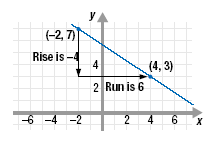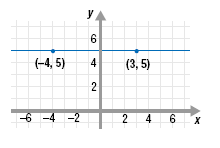The Slope of a Line
The rise of a line represents the vertical change when moving from one
point to a second point on a line.
The run of a line represents the horizontal change when moving from one
point to a second point on the line.
The slope of a line is the ratio of the rise to the run. It is a number that
describes the steepness of the line.
Definition
Slope of a Line
The slope of the line that passes through two points, (x1, y1) and
(x2, y2), is given by
slope

where x1 ≠ x2.

Example 1
Find the slope of the line that passes through the points (-2, 7) and (4, 3).
Solution

Note:
When using the slope formula, it does not
matter which point we choose for (x1, y1) and which we choose for (x2, y2).
Example 2
Find the slope of the line that passes through the points (-4, 5) and (3, 5).
Solution
| Let (x1, y1) = (-4, 5) and (x2, y2)
= (3, 5). |
m |
 |
| Substitute these values in the slope formula. |
|
 |
| Simplify. |
|
 |
| Divide. |
|
= 0 |
| Thus, the slope of the line through (-4, 5) and (3, 5) is 0.
In fact, the slope of any horizontal line is 0. |
|
|

|